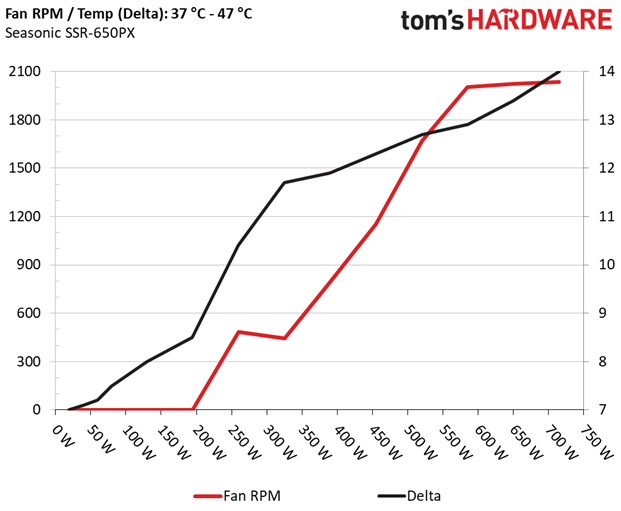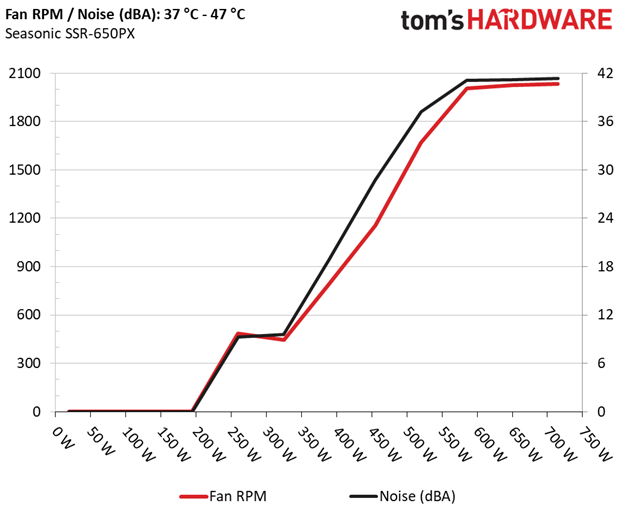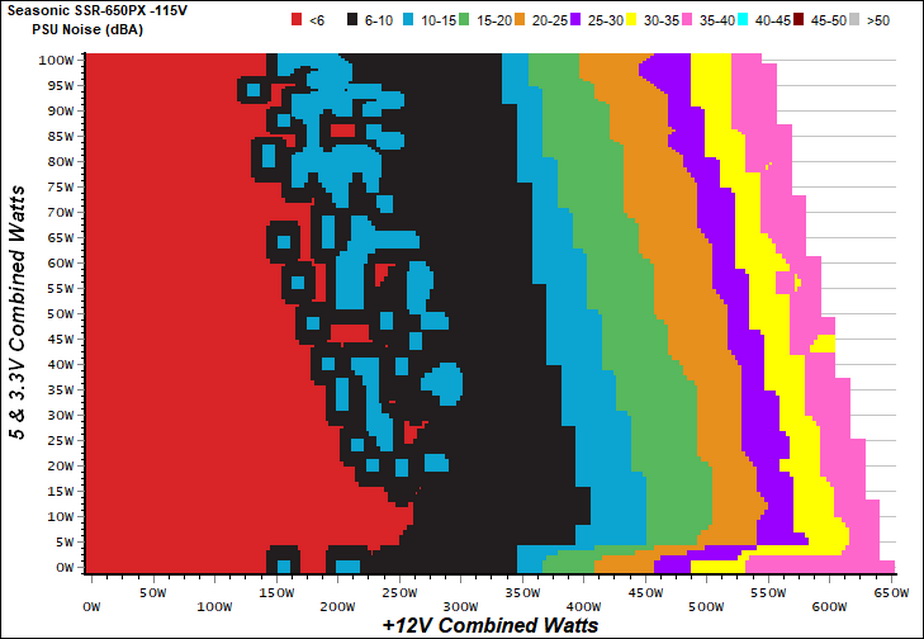Seasonic SSR-650PX PSU Review: High Performance Without Breaking The Bank
Why you can trust Tom's Hardware
Efficiency, Temperature & Noise
Efficiency
Our efficiency testing procedure is detailed here.
Using results from the previous page, we plotted a chart showing the SSR-650PX’s efficiency at low loads, and loads from 10 to 110 percent of its maximum-rated capacity.
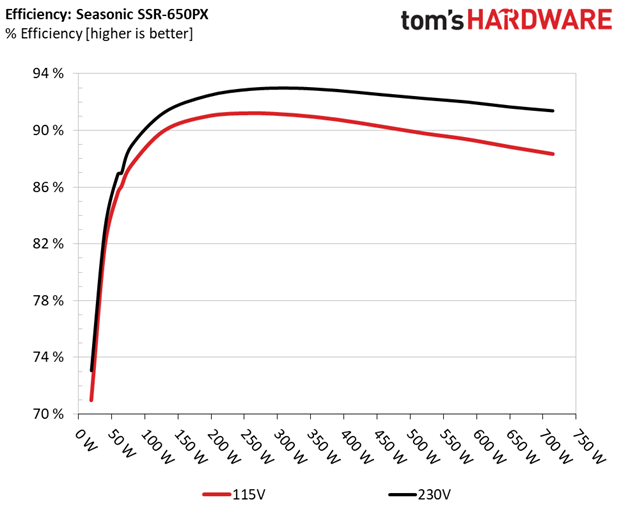
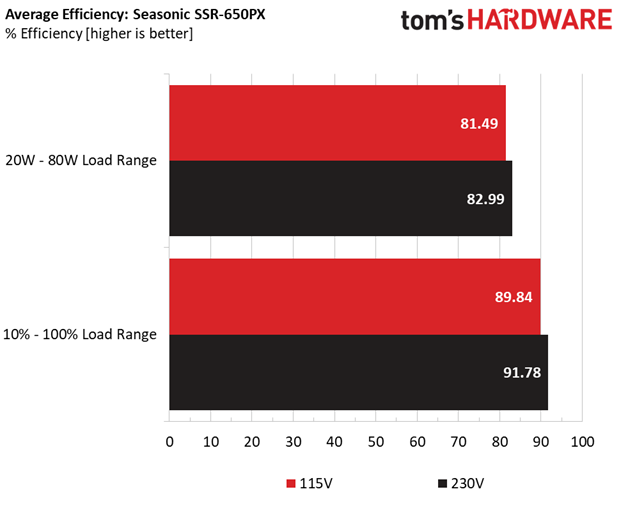
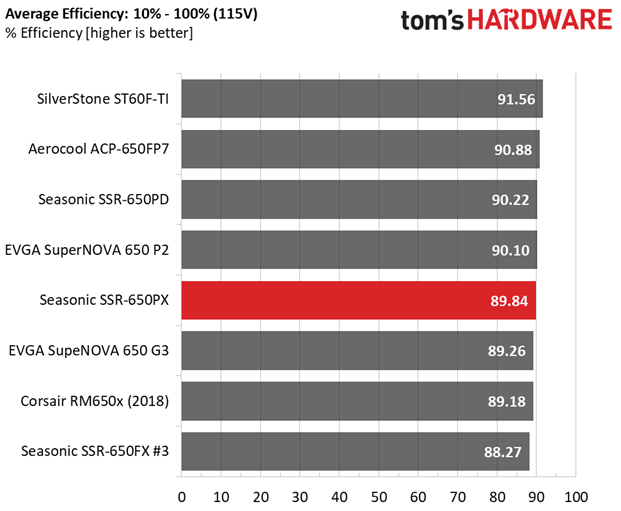
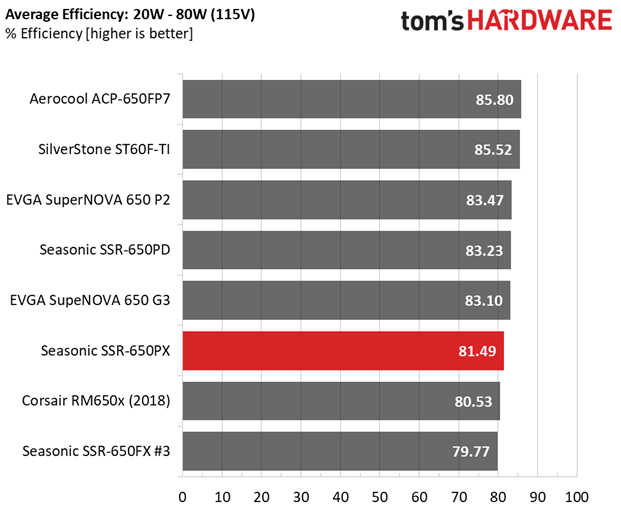
Under normal loads, the SSR-650PX appears between EVGA's P2 and G3 models. With light loads it lands lower in our chart.
Efficiency At Low Loads
In the following tests, we measure the SSR-650PX's efficiency at loads significantly lower than 10 percent of its maximum capacity (the lowest load the 80 PLUS standard measures). The loads we dial are 20, 40, 60, and 80W. This is important for representing when a PC is idle, with power-saving features turned on.
| Test # | 12V | 5V | 3.3V | 5VSB | DC/AC (Watts) | Efficiency | Fan Speed | PSU Noise | PF/AC Volts |
|---|---|---|---|---|---|---|---|---|---|
| 1 | 1.172A | 0.494A | 0.480A | 0.196A | 19.296 | 70.980% | 0 RPM | <6.0 dB(A) | 0.860 |
| 12.128V | 5.035V | 3.319V | 5.107V | 27.185 | 115.34V | ||||
| 2 | 2.427A | 0.993A | 0.995A | 0.392A | 39.729 | 81.845% | 0 RPM | <6.0 dB(A) | 0.930 |
| 12.129V | 5.029V | 3.316V | 5.100V | 48.542 | 115.32V | ||||
| 3 | 3.619A | 1.490A | 1.476A | 5.094A | 59.286 | 85.605% | 0 RPM | <6.0 dB(A) | 0.957 |
| 12.130V | 5.029V | 3.316V | 5.094V | 69.255 | 115.29V | ||||
| 4 | 4.873A | 1.987A | 1.989A | 0.786A | 79.711 | 87.547% | 0 RPM | <6.0 dB(A) | 0.970 |
| 12.133V | 5.029V | 3.316V | 5.088V | 91.049 | 115.26V |
Registered efficiency is good under light loads. However, there are PSUs with similar specifications that achieve notably higher efficiency under the same conditions.
5VSB Efficiency
The ATX specification (revision 1.4), along with CEC, ErP Lot 3 2014 and ErP Lot 6 2010/2013, states that 5VSB standby supply efficiency should be as high as possible, recommending 75 percent or higher with 550mA, 1A, and 1.5A of load. The PSU should also achieve higher than 75% efficiency at 5VSB under full load, or with 3A if its max current output on this rail is higher than 3A.
We take six measurements: one each at 100, 250, 550, 1000, and 1500mA, and one with the full load the 5VSB rail can handle.
Get Tom's Hardware's best news and in-depth reviews, straight to your inbox.
| Test # | 5VSB | DC/AC (Watts) | Efficiency | PF/AC Volts |
|---|---|---|---|---|
| 1 | 0.100A | 0.511 | 73.420% | 0.059 |
| 5.110V | 0.696 | 115.25V | ||
| 2 | 0.250A | 1.276 | 76.361% | 0.135 |
| 5.107V | 1.671 | 115.26V | ||
| 3 | 0.550A | 2.805 | 77.593% | 0.251 |
| 5.100V | 3.615 | 115.26V | ||
| 4 | 1.000A | 5.090 | 77.984% | 0.350 |
| 5.091V | 6.527 | 115.26V | ||
| 5 | 1.500A | 7.619 | 78.072% | 0.408 |
| 5.080V | 9.759 | 115.26V | ||
| 6 | 3.000A | 15.106 | 76.335% | 0.479 |
| 5.036V | 19.789 | 115.25V |
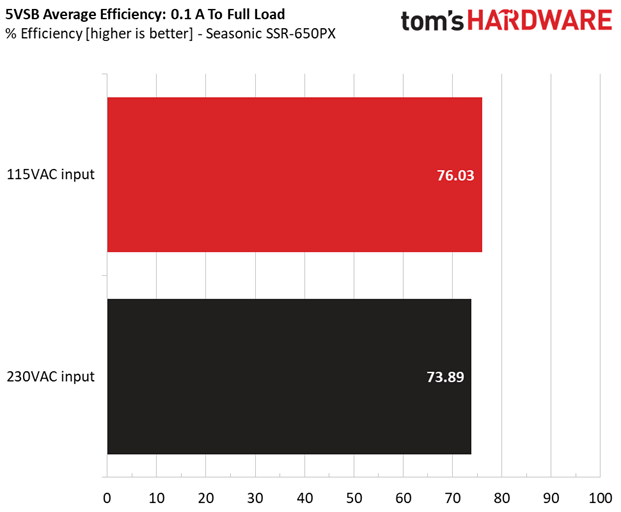
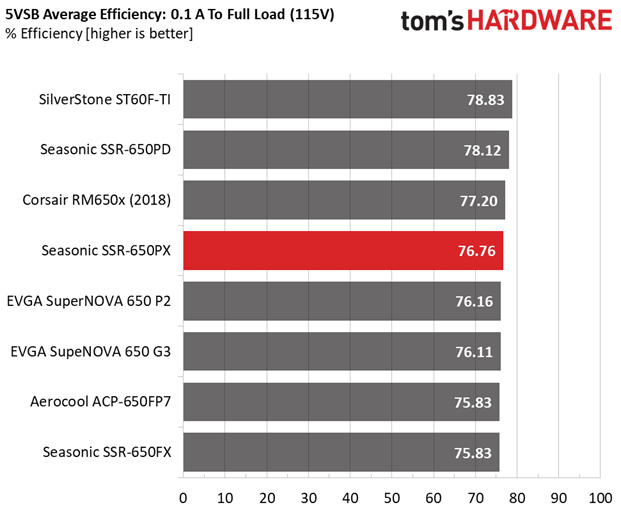
We would like to see at least one reading with efficiency close to 80%. Still, compared to the other PSUs we included in our chart, the SSR-650PX does fare pretty well.
Power Consumption In Idle And Standby
In the table below, you'll find the power consumption and voltage values of all rails (except -12V) when the PSU is idle (powered on, but without any load on its rails), and the power consumption when the PSU is in standby mode (without any load, at 5VSB).
| Mode | 12V | 5V | 3.3V | 5VSB | Watts | PF/AC Volts |
|---|---|---|---|---|---|---|
| Idle | 12.126V | 5.035V | 3.319V | 5.113V | 6.988 | 0.484 |
| 115.4V | ||||||
| Standby | 0.050 | 0.004 | ||||
| 115.3V |
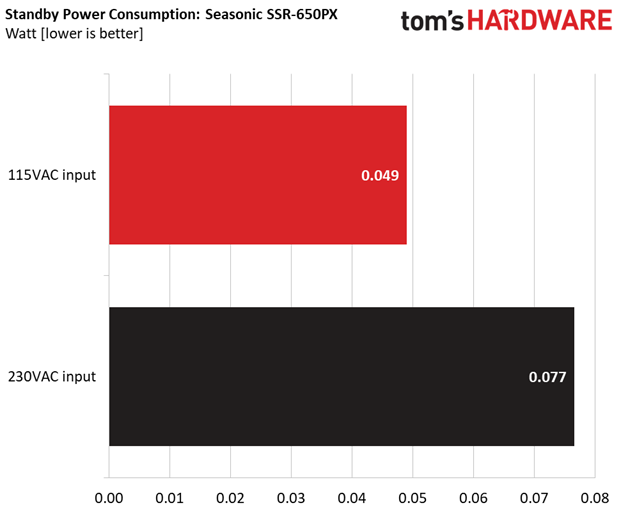
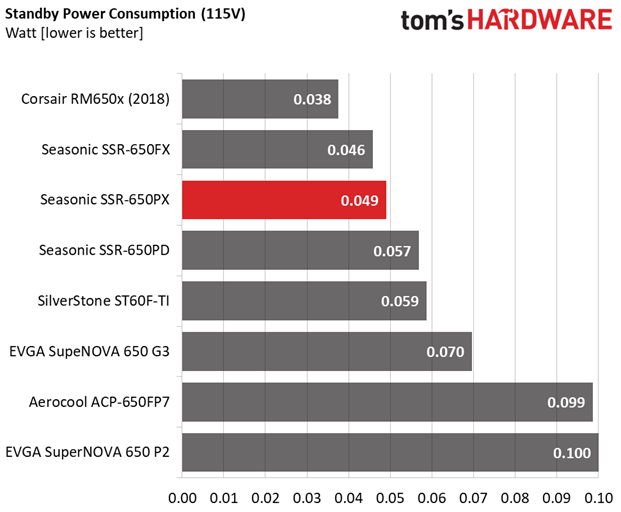
Vampire power is kept low with both voltage inputs.
Fan RPM, Delta Temperature, And Output Noise
Our mixed noise testing is described in detail here.
The first chart below illustrates the cooling fan's speed (in RPM), and the delta between input and output temperature. The results were obtained at 37°C (98.6°F) to 47°C (116.6°F) ambient temperature.
The next chart shows the cooling fan's speed (again, in RPM) and output noise. We measure acoustics from one meter away, inside a hemi-anechoic chamber. Background noise inside the chamber is below 6 dB(A) during testing (it's actually much lower, but our sound meter’s microphone hits its floor), and the results are obtained with the PSU operating at 37°C (98.6°F) to 47°C (116.6°F) ambient temperature.
The following graph illustrates the fan's output noise over the PSU's operating range. The same conditions of the above graph apply to our measurements, though the ambient temperature is between 30°C (86°F) to 32°C (89.6°F).
The semi-passive mode doesn't last long. We don't have a problem with that, though, since components sensitive to heat won't endure more stress than necessary. Up to around 350W load (at +12V), the PSU's noise stays low. We need 490W and more to push the fan beyond 30 dB(A).
MORE: Best Power Supplies
MORE: How We Test Power Supplies
MORE: All Power Supply Content
Current page: Efficiency, Temperature & Noise
Prev Page Load Regulation, Hold-Up Time & Inrush Current Next Page Protection Features
Aris Mpitziopoulos is a contributing editor at Tom's Hardware, covering PSUs.
-
DookieDraws I won't put anything in my builds, or builds I do for others, other than a Seasonic PSU. Used them for years and have never had any issues. Not saying there isn't any other reliable brands out there, as I know there are, but I'm sticking with what has worked for me.Reply -
mlee 2500 What a Coincidence! I bought this very same Seasonic 650PX Power Supply and just last night finally took it out of the box to prep for my new build...and here I find a review for it!!Reply
The author makes an excellent point that a 2nd modular EPS cable really should be standard these days. With motherboards now supporting USB 3.1, integrated WiFi, a whole slew of 2A fan/pump connectors and tons of other power-drawing features which hardly even existed a decade ago, a second EPS is quickly becoming the norm rather then the exception.
In my case, with the very popular ASrock Taichi Z series motherboards which requires three connectors (1x24, 1x8, 1x4), I need to obtain a second additional 8pin to 2x4 modular cable. I just happened to contact Seasonic about that not an hour before seeing this review and learned that www.btosinte.com is their approved distributor and that such a cable costs about $5.00
If you do need to buy an additional EPS cable, BE SURE TO GET THE ONE WITH THE INLINE CAPACITOR, for the newer SSR series!!
It was interesting to learn from this article that providing a second EPS cable isn't really typical for most vendors 650W power supplies, which makes me feel better about being in that predicament with Seasonic. I was initially a bit disappointed, but then I've never had a Desktop mobo which required so many connectors before.
All that being said this appears to be an outstanding power supply, a great value, and given that my previous modular Seasonic Power Supply is still running great after more then 6 years, I remain a Seasonic customer until proven I shouldn't be. -
Aris_Mp I am insisting for quite some time for a second EPS connectors in high-end PSUs and your post clearly shows why. Thank you!Reply
